Exploring Waves in Iconic Artworks
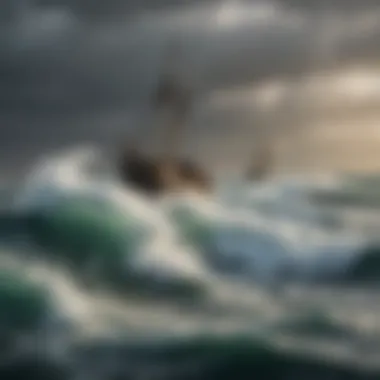
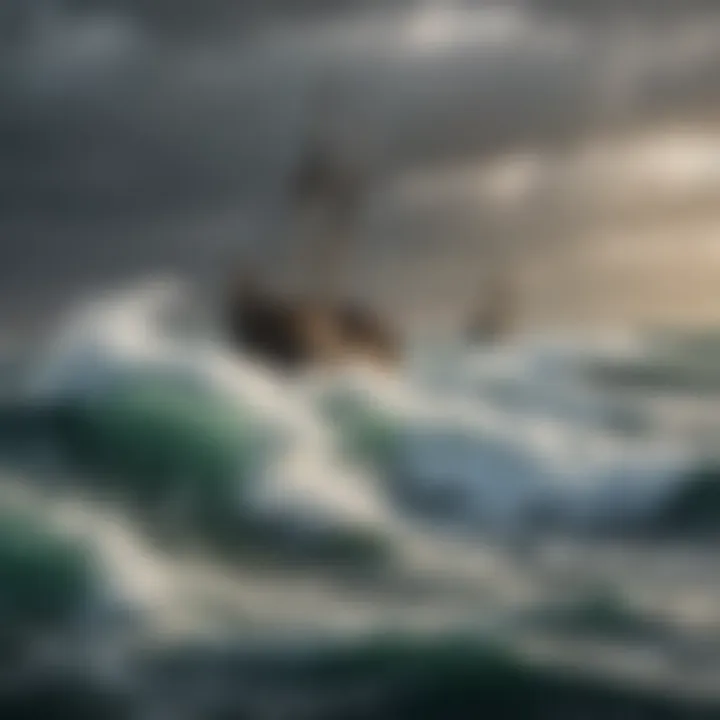
Intro
Waves have been a source of inspiration for countless artists throughout history. Their movement, sound, and unpredictability mirror the complexities of human emotion and experience. This article aims to peel back the layers of how waves have been depicted in famous paintings, revealing their significance in the art world.
From the frothy whitecaps of the ocean to the serene ripples of a quiet lake, water has found its way into the hearts of artists in various styles and time periods. The power of waves—both calming and tumultuous—often serves as a backdrop to the scenes of our lives, and their representations in art reflect the cultures and eras from which they arose.
As we explore the artistic portrayal of waves, we will look at specific notable paintings that illuminate the relationship between nature and creativity. Each piece tells a story, drawing viewers into its depths while bridging a connection to the broader experience around us.
In examining this relationship, we will discuss the historical contexts that informed these artworks and the techniques that artists used to capture the essence of waves. This exploration not only enriches our understanding of visual narratives but also highlights how the ocean continues to inspire a profound appreciation for nature in human expression.
Preamble to Waves in Art
The depiction of waves in art is a profound subject, weaving together aesthetics, symbolism, and cultural significance. Waves are more than just physical phenomena; they are representations of emotions, power, tranquility, and unpredictability. Understanding how artists throughout history have captured these dynamic forms can deepen our appreciation for both nature and art.
Artistic interpretations of waves resonate with a wide range of audiences, from surfers to casual beachgoers. For those who find solace in the ocean, paintings featuring waves might evoke memories of summer days or adventures on the water. From an artistic standpoint, waves offer a way to explore movement, color, and light, creating a rich tapestry of visual experiences.
Delving into the artistic representation of waves also reveals a connection to the environmental themes of our time. As artists interpret the beauty of the ocean, they highlight its fragility, often reflecting a world grappling with ecological concerns. In this way, waves serve not only as subjects but also as symbols of the relationship between humanity and nature.
Cultural Symbolism of Water
Water has long held a prominent place in various cultures, signifying purity, life, and depth. The symbolic nature of water runs deep; it connects to emotions and spiritual themes. In many cultures, waves symbolize the cyclical nature of life, constantly ebbing and flowing. This connection to the sea is evident in works from different eras and regions.
- In Eastern traditions, water often represents wisdom and enlightenment. Artists like Katsushika Hokusai used waves to reflect not only the beauty of nature but also the transformative power of water.
- Western art, during the Romantic period, often depicted dramatic seas and turbulent waves to illustrate the sublime - the blend of beauty and terror.
These cultural nuances add layers of meaning to artistic representations of waves. Whether depicted in calming blue hues or punctuated with tumultuous white caps, waves encapsulate the spirit of humanity’s relationship with the oceans.
Historical Context of Marine Art
The history of marine art dates back centuries and evolves with the cultural and technological changes of the times. In earlier periods, art focused primarily on practical depictions—maps and navigational charts often featured artistry to convey the expansiveness of the ocean. As time flowed, artists began to embrace aesthetics over utility.
The 17th and 18th centuries marked a golden age for marine art, especially in European countries like the Netherlands and England. Artists such as J.M.W. Turner and Albert Bierstadt captured the majesty of the ocean, using techniques that evoked emotion and drama as if the viewer could feel the salt spray on their skin.
Their works not only served to satisfy the public's fascination with the sea but also reflected the broader historical experiences of exploration and colonialism.
In summary, the importance of waves in art is multifaceted. As we explore these elements, it becomes clear that waves inspire a deeper understanding of cultural heritage, historical perspectives, and the ever-evolving narrative of humanity's intrinsic bond with the ocean.
The Great Wave off Kanagawa
Hokusai’s The Great Wave off Kanagawa is not just a mere painting; it’s a cultural touchstone that captures the sheer power and beauty of the ocean. Created during the Edo period in Japan, this artwork has transcended its time, resonating with diverse audiences across epochs. The wave, depicted in a way that seems almost to leap off the canvas, embodies the relationship between humankind and nature. For surfers, paddleboarders, and anyone with a love for the ocean, it reflects the thrill and danger that can coexist in such environments. This piece offers a vivid visualization of how dynamic and sometimes ferocious the sea can be, serving as a magnet for enthusiasts drawn to the water.
Artist Background: Hokusai
Katsushika Hokusai was a pivotal figure in Japanese woodblock printing and one of the most renowned artists of the ukiyo-e genre. Born in 1760, Hokusai's works are characterized by their intricate detail and bold use of color. His interest in capturing the natural world is evident throughout his oeuvre, but it is The Great Wave off Kanagawa that has left an indelible mark on art history. His background as an artist steeped in the traditions of landscape and cultural storytelling lends a unique perspective to his representation of waves—highlighting the tension not just between man and nature, but also within the very fabric of Japanese tradition itself.
Composition and Technique
The composition of The Great Wave off Kanagawa showcases Hokusai's masterful understanding of balance and perspective. The wave curls ominously above three small boats, each occupied by fishermen striving against the formidable force of nature. Hokusai employs a technique known as ukiyo-e, which involves carved wooden blocks and ink to produce prints that convey both color and depth.
- The iconic blue pigment known as Prussian blue gives the wave a striking contrast against the white foam, making it pop in a sea of muted tones.
- Hokusai’s delicate lines form intricate patterns, emphasizing the wave's fluidity while simultaneously imparting a sense of urgency.
- The mountains in the background are rendered more subdued, grounding the composition and drawing the viewer’s focus to the tumultuous wave ahead.
This approach offers a deeper understanding of the power of waves—both formidable and beautiful. Hokusai's attention to detail, coupled with his innovative techniques, creates an image that feels alive and dynamic.
Interpretation and Legacy
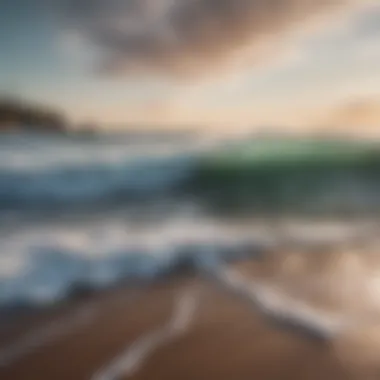
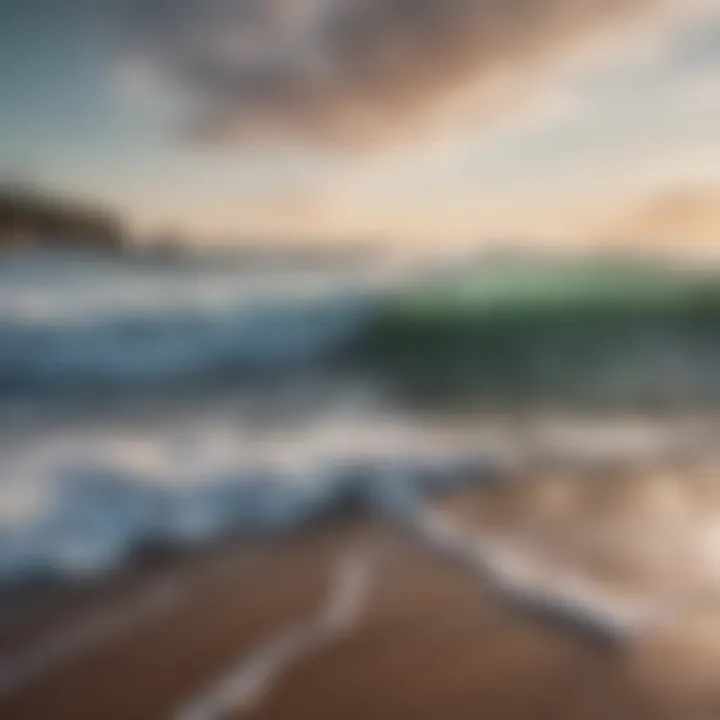
Moreover, The Great Wave off Kanagawa is rich in interpretation. While the wave signifies nature’s raw strength, the small boats symbolize human endeavor. This dynamic interplay raises questions about resilience, risk, and the human spirit in the face of overwhelming challenges. The legacy of this piece extends well beyond the art world; it inspires surf enthusiasts and ocean lovers alike to respect and embrace the unpredictable nature of the sea.
"The wave is a metaphor for life’s unpredictable nature, where calm and chaos often collide."
The artwork has influenced countless artists and remains a central work in discussions about marine art. Its presence in modern pop culture—from tattoos to merchandise—underscores its relevance and timelessness. For those who paddleboard, kite surf, or simply love observing the waves, Hokusai’s masterpiece serves as a constant source of inspiration and reverence for the ocean's complexities.
Impressionist Representations of Waves
Impressionism marks a pivotal shift in how artists approached representation of nature, especially waves. For many Impressionists, it wasn’t merely about capturing a realistic view but also about translating the emotional essence of a moment. The play of light on water, the vibrant hues of the sky reflecting on the crests, and the ephemeral atmosphere of coastal scenes became central to their craft. Thus, when we sift through the layers of paint applied by the Impressionist masters, we encounter not just waves, but the very feel of the ocean breeze and the pulsating rhythm of the surf.
The approach adopted by these artists offers various benefits and considerations. For one, focusing on waves allows a deeper connection to the dynamics of movement. The energy that water brings to an artwork transmits feelings of calmness or tumult, depending on how the waves are portrayed. Furthermore, impressionist waves often carry a sense of immediacy; the viewer gets the impression that they are experiencing the scene first-hand, adding to the allure of such depictions.
Monet's Ocean Landscapes
Claude Monet, perhaps the leading figure of Impressionism, created extraordinary works featuring ocean landscapes. His paintings of the sea depict not only the waves but also the interplay between light and water. One particularly notable series is his work focusing on the cliffs of Étretat, where the waves crash against the rocky coast.
Monet's mastery in portraying water is evident in pieces like "Impression, Sunrise" and "The Seine at Argenteuil". Here, he marshaled soft colors and brushstrokes that suggest both movement and tranquility, always allowing the viewer's imagination to fill in the gaps. It’s in these nuances that Monet captures the fleeting quality of nature, reminding us of the continual change inherent in the tides.
His use of color palette is remarkably diverse yet focused, bringing in pastel shades that depict reflections on the water while utilizing bold strokes in the foreground to evoke the waves themselves. This balance creates a harmonious dialogue between the canvas and its viewers, enticing them to dive deeper into the scene and interpret it in their own way.
Technique and Texture Analysis
The technique Monet employed in his ocean landscapes is a study in textural variety. His brushwork is typically characterized by short, quick strokes, which help to convey movement and light. This choice allows the surface of the waves to appear dynamic, almost alive. The tactile quality achieved through these methods adds dimension to the painting, making the waves not just a backdrop but a central character in the story being told.
A closer analysis reveals how the contrast of colors contributes to the texture. The juxtaposition of darker shades with lighter, airy colors simulates the varied depths and speeds of the water. This creates a vibrant surface that draws the eye, inviting an interaction with the painting, compelling the observer to explore the play of light upon the water.
Understanding Monet’s technique allows viewers to appreciate the intricate relationship between artist and ocean as they seek to portray waves not just as physical forms but as emotional experiences.
The Role of Waves in Romantic Art
Waves in Romantic art are more than mere backdrops; they embody the emotional turbulence and the sublime beauty that characterizes this artistic movement. The tumultuous nature of the sea reflects both the external world and the internal conflicts faced by humanity. Romantic artists, through their depiction of waves, magnificently mirrored the unpredictability of emotions and experiences.
Turner and the Sublime
One cannot discuss waves in Romantic art without highlighting the contributions of J.M.W. Turner. His works, steeped in atmospheric qualities, often play with light and shadow to emphasize the power of nature. In pieces such as "The Shipwreck" and "The Fighting Temeraire," the waves serve as a prominent element, creating an overwhelming sense of awe. Turner painted the ocean not simply as a geographical feature but as a powerful force that commands respect.
His strokes capture not only the physical characteristics of the waves but also their emotional weight. The frothy crests and rolling bodies of water mirror the chaos in the human spirit, inviting viewers to lose themselves in a whirlpool of feelings.
"The sea is the greatest teacher of all things, of which man must be aware of his smallness" - an idea Turner embraces, drawing observers to reflect on their own place in the universe.
Emotion and Turbulence on Canvas
The representation of waves in Romantic art also delves into the theme of inner conflict. Artists like Caspar David Friedrich exemplified this by situating solitary figures against vast oceanic expanses, reflecting their isolation and existential struggles. In Friedrich’s works, crashing waves symbolize emotional unrest, a crossroads where nature’s fury intersects with human fragility.
At times, the raging ocean in these artworks feels almost anthropomorphic. It encapsulates the yearning and despair of the figures portrayed, producing a visceral connection between viewer and subject. Waves rise and fall, echoing the highs and lows of life itself, and remind us that nature does not shy away from chaos.
Ultimately, the role of waves in Romantic art speaks volumes about the human experience. They challenge us to confront our fears while also appreciating the beauty found in the tumult. Such intricate portrayals continue to resonate today, reminding us that emotional depth often mirrors the unpredictable nature of the sea.
Modern Interpretations of Waves
The modern interpretations of waves in art serve as a testament to our evolving relationship with the ocean. With an increasing awareness of environmental issues and technological advances, artists today are reshaping how we perceive and connect with these powerful natural forces. This section delves into the significance of waves as a motif in contemporary art, highlighting its relevance in today’s world.
Waves symbolize a range of emotions and ideas, from tranquility to chaos, reflecting both the beauty and the unpredictability of the sea. By exploring modern interpretations, we recognize a growing appreciation for ecological concerns and the emotional weight that oceanic imagery carries in contemporary society. Throughout this exploration, new techniques and materials are employed, showcasing the artistry's intersection with urgency and activism.
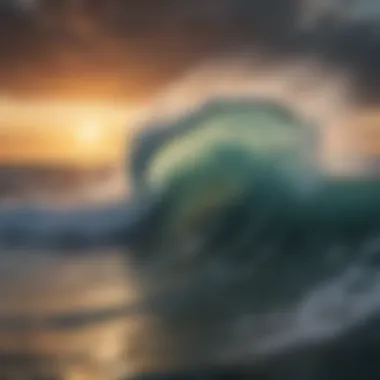
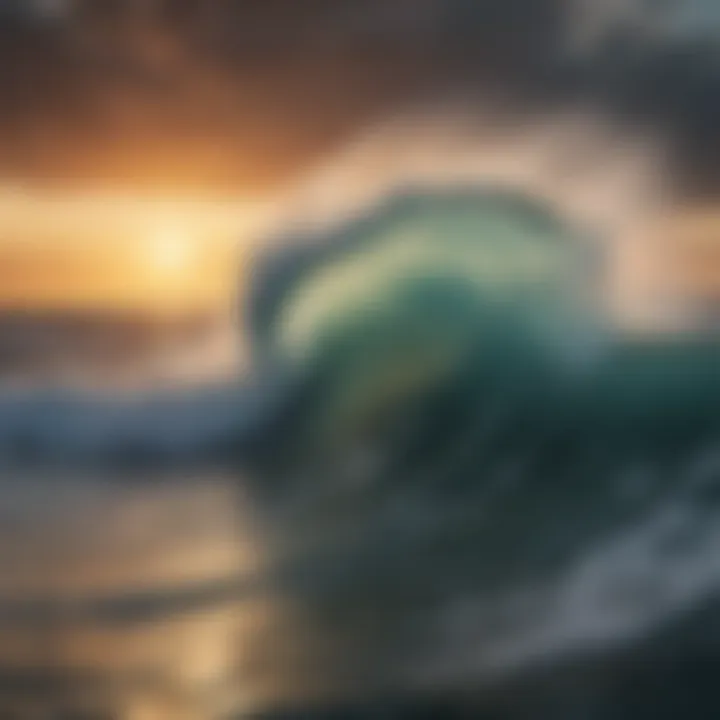
Contemporary Artists and Wave Motifs
In the realm of contemporary art, various artists have embraced wave motifs, reflecting the complexity of our relationship with water. For instance, the works of Cecily Brown often feature tumultuous seascapes that echo human emotional states. In her paintings, waves morph into abstract forms, suggesting that nature mirrors human turmoil. Similarly, Yayoi Kusama incorporates aquatic themes in her immersive installations, where large-scale sculptures evoke the enchanting beauty of waves, inviting viewers to lose themselves in their patterns.
Some artists focus on environmental activism, using wave imagery as commentary on climate change. Chris Burden’s installation works can symbolize the rising concerns about sea levels and coral bleaching, amplifying the urgency through poignant visuals. Contemporary artists serve as conduits for dialogue on sustainability, urging us to reflect on our ocean’s plight. Through their waves, they pull at heartstrings and beckon us towards action.
Intersection with Abstract Art
The interaction of waves with abstract art has created a fascinating dialogue that bridges emotional expression with visual dynamism. Abstract artists often break down the forms and rhythms of waves into fundamental shapes and colors, utilizing them as vehicles for conveying complex ideas and feelings. This approach allows viewers to engage with the artwork on a sensory level, nurturing a more personal interpretation.
Jackson Pollock's drip paintings, while not explicitly about waves, may evoke the fluidity and motion found in water. The energy and chaos in his work resonate with the unpredictable nature of the ocean.
On the other hand, Zao Wou-Ki seamlessly blends abstraction with representation through his works, where waves are manifested in fluid brush strokes and vibrant colors. His pieces often suggest the power and beauty of water, evoking a sense of serenity amidst chaos. Additionally, the use of color gradation can mimic the transitional hues of a wave cresting at sunset, creating a visual harmony that enchants viewers.
The Environmental Message in Ocean Art
The portrayal of waves and oceanic landscapes in art speaks volumes about our natural world and the delicate balance within it. The environmental message encapsulated in ocean art emerges as an urgent and vital conversation amid growing ecological concerns. As artists depict the beauty, chaos, and power of the ocean, they invite viewers to reflect on the profound relationship between humans and nature. This intricate dialogue not only fosters appreciation but also raises awareness about critical environmental issues, emphasizing that art can be a powerful catalyst for change.
Art as a Reflection of Ecological Concerns
Art carries a mirror reflecting the state of our environment, particularly focusing on oceans that are often overlooked. Many artists have honed their skills to convey not just the visually stunning aspects of waves but also their vulnerability. For instance, contemporary works sometimes incorporate discarded materials or utilize contrasting color palettes to illustrate pollution's dire impact on marine life. This can be seen in the works of artists like Chris Jordan, who explores the relationship between consumption and ecological degradation.
The use of symbolism is prevalent in these representations. A crashing wave may symbolize destruction, while calm waters might signify tranquility—making us reflect on what we may be losing or what can still be saved. It’s not just about aesthetics; it’s about narratives that compel one to think critically about the ocean’s fate. Sea turtles entangled in plastic are not merely subjects but poignant reminders of the consequences of human actions.
Moreover, significant marine events that artists capture—such as coral bleaching or the impacts of climate change—serve as urgent narratives that demand attention. Waves, which might appear beautiful, can be a tragic reminder of rising sea levels and environmental degradation that threaten coastal communities. Through these lenses, art provides a crucial perspective on the often ignored or misunderstood crises that our oceans face.
Activism through Artistic Expression
Art has gradually evolved into a vibrant platform for activism, especially concerning environmental issues surrounding oceans. Artists increasingly leverage their creativity not just to express aesthetic views but to advocate for environmental stewardship. This includes using their work to start conversations about pollution, climate change, and the urgent need for conservation efforts. Some modern pieces transform galleries into immersive experiences, where viewers interact with elements that symbolize environmental degradation, profoundly impacting their understanding of the issues at hand.
For example:
- The Ocean Cleanup project effectively combines technology with the visual arts to raise awareness about plastic waste in the oceans. Artists collaborate with scientists, transforming horrific statistics into striking visuals that resonate with people. Such collaborations drive home the message that action is needed, and everyone has a role to play.
- Activism is also reflected in community projects, where murals painted on walls portray local marine species and their habitats, aiming to educate neighborhoods about their ecological significance. These art pieces become landmarks, continually educating passersby and planting seeds of environmental consciousness.
"Art can be a powerful vehicle for change; it can engage the public and inspire action where facts and statistics often fall short."
Comparative Analysis of Wave Art
Understanding how different cultures have viewed waves and their artistic representations offers a unique perspective on the relationship between nature and art. A comparative analysis of wave art not only reveals the distinct artistic styles and techniques employed across various regions but also highlights how cultural beliefs, historical contexts, and geographical factors influence these depictions. This analysis serves a dual purpose: it enriches our appreciation of individual artworks and enhances our understanding of the global significance of water.
East vs. West: Different Aesthetic Approaches
When diving into the aesthetic approaches towards waves, an intriguing dichotomy emerges between Eastern and Western perspectives. Eastern art, particularly in countries like Japan, often emphasizes harmony with nature. For instance, Katsushika Hokusai’s iconic piece "The Great Wave off Kanagawa" embodies an intricate balance between beauty and terror. The wave takes center stage, appearing almost alive, while the distant Mount Fuji lends stability and serenity.
In contrast, Western art typically emphasizes the dramatic power of nature. Think of J.M.W. Turner, whose swirling seas portray nature's tempestuous heart. Works like "The Storm" showcase waves as vigorous forces of nature, evoking strong emotions in viewers. This divergence illustrates that waves can symbolize tranquility in one culture, while in another, they might represent chaos and sublime beauty.
Both perspectives provide valuable insights, offering layers of meaning that can enhance one's appreciation of wave-focused art.
Techniques Across Cultures
The techniques artists use to depict waves vary significantly between cultures, demonstrating different understandings and representations of water. In traditional Japanese woodblock prints, artists harness the power of line and color to create striking contrasts. The use of negative space, particularly in Hokusai's work, gives waves a pronounced, almost tactile quality that draws viewers' eyes.
Conversely, Western artists often use oil paints to capture light and movement. Turner, for instance, mastered glazes and layering techniques to render light's interplay over water, creating a sense of motion and emotion within his scenes.
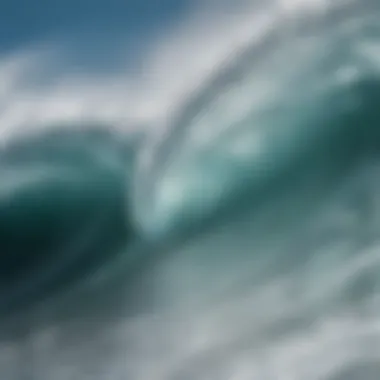
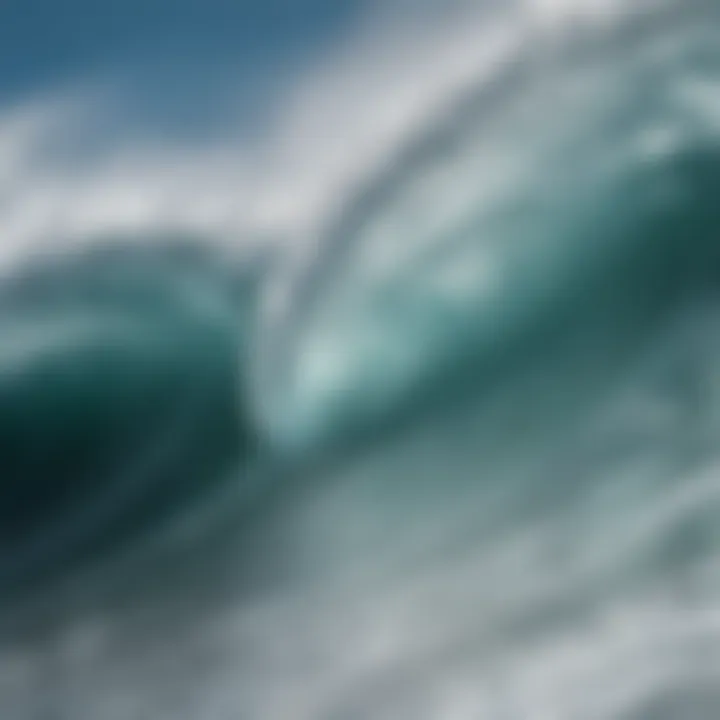
Some noteworthy techniques employed across cultures include:
- Color Application:
- Perspective:
- Textural Elements:
- Eastern art often uses watercolors and ink, focusing on fluidity and simplicity.
- Western art tends to favor oil paints, enabling a depth that captures the tumult of waves.
- Japanese prints use a flattened perspective, engaging the viewer on a more intimate level.
- Western interpretations might employ dramatic foreshortening, enhancing the illusion of depth and distance.
- Traditional Eastern methods emphasize smooth, flowing lines conveying grace.
- Western artists might use impasto techniques to create textured surfaces that reflect the tumultuous nature of the sea.
These diverse techniques not only showcase the personal touches of each artist but also reflect broader cultural narratives regarding the sea, from fears of its power to admiration of its beauty.
Ultimately, a comparative analysis of wave art embroils viewers in a discussion that extends beyond aesthetics, weaving in cultural, emotional, and historical threads.
The Influence of Technology on Wave Art
In today’s artistic landscape, technology plays a monumental role in shaping how waves are depicted on canvas and screen. It influences not only the approach artists take but also how viewers engage with these pieces. This section explores various aspects of this influence, highlighting the intersection between technology and the natural beauty of waves.
Digital Art and Wave Representation
The realm of digital art has unlocked a treasure trove of opportunities for artists keen on wave representation. Through software like Adobe Photoshop or Procreate, creators can manipulate colors, textures, and forms with a level of precision not possible with traditional methods. This capability allows for the transformation of a seemingly mundane photo of waves into an immersive piece of art.
- Fluidity and Movement: Programs allow artists to simulate the mesmerizing motion of waves. By using animations, these digital artisans can create a sense of motion that makes the ocean feel alive, breathing with every swell. Artists like Takashi Murakami use this approach, blending traditional aesthetics with contemporary technology to depict waves that pulse with energy.
- Accessibility: Digital tools make it easier for budding artists to get their feet wet, regardless of their formal training. Online platforms often host tutorials and share techniques, encouraging a new generation of artists to explore marine art, democratizing the creative process.
"In the digital space, you can paint with the ease of a swipe, letting your imagination flow in ways that traditional brush strokes might not allow."
This accessibility creates a diverse range of styles and interpretations of waves, as artists from various backgrounds contribute their perspectives.
The Evolution of Artistic Mediums
We live in an era where art mediums are continually evolving, reshaping the visual narrative of waves. It’s fascinating to trace how artists have transitioned from oils and watercolors on canvas to multimedia and installations.
- Traditional to Digital: The evolution mirrors society’s relationship with technology. Early painters relied on natural elements like pigments from minerals and plants to achieve the sapphire blues of the ocean. Now, they can manipulate color and light, combining digital painting with photography in ways that recreate the real and surreal.
- Installation Art: Moreover, many contemporary artists employ installations that use projection, sound, and even physical water movements. These immersive experiences evoke a feeling of being enveloped by waves, engaging more senses than traditional art typically would.
By pushing the boundaries, artists keep the depiction of waves fresh and culturally relevant. In the end, these technological advances not only enhance the techniques used but also challenge the viewer’s understanding of what art can be.
As we continue to navigate this digital frontier, the artistic depiction of waves remains a dynamic discussion—reflecting not just the ever-changing nature of the ocean but also the evolving nature of artistry itself.
Epilogue
In the realm of visual art, the exploration of waves as a theme and symbol holds a remarkable place. This conclusion emphasizes the profound impact that wave imagery has had on artistic expression, transcending mere representation to encapsulate deeper cultural, emotional, and environmental significance. Waves are not just elements of nature—they embody movement, change, and the interplay of forces, making them a rich topic for artists across ages and styles.
The Enduring Nature of Wave Imagery
Wave imagery has stood the test of time, appealing to audiences and creators alike due to its dynamic qualities and inherent beauty. Artists such as Hokusai, Turner, and Monet have utilized waves to express feelings ranging from serenity to turmoil. The fluidity of water allows painters to explore and convey complex emotions, as well as their own personal journeys.
This imagery often appears as a metaphor for life's uncertainties and the constant ebb and flow of human experiences. In essence, the ocean's waves mirror human emotions—sometimes calm and at other times turbulent.
- Cultural connections: In various cultures, waves symbolize life, death, and rebirth, making their representation layered and multifaceted.
- Technological advancements: As mediums evolve from classic oil paintings to modern digital art, waves remain relevant, adapting to contemporary concerns like climate change and environmental degradation.
Artists today still harness the power of waves to echo social messages, reflecting on humanity's relationship with the ocean. The artistic depiction of waves not only astounds viewers but also invites them to ponder their significance in our lives.
Future Directions in Marine Art
Looking ahead, the future of marine art—and wave imagery in particular—seems poised for exciting developments. Several emerging trends hint at what might be on the horizon:
- Digital Art: The rise of digital mediums presents novel ways for artists to convey the essence of waves. Techniques such as animation and interactive installations could provide immersive experiences that draw viewers into wave dynamics.
- Ecological Art: A growing awareness of environmental issues has led artists to focus on maritime themes that highlight the fragility of ocean ecosystems. They are addressing topics such as pollution and climate change, encouraging audiences to engage with these pressing concerns.
- Cross-disciplinary Collaborations: Art practices intersecting with science, technology, and policy can generate impactful artworks that not only represent waves but also advocate for change.
- Interactive Exhibitions: Future exhibitions may offer interactive elements that allow viewers to experience waves viscerally, for instance through soundscapes that replicate the ocean's rhythm.
As we move forward, wave art will continue to evolve, driven by advancements in technology and an increasing commitment to addressing environmental issues. This symbiotic relationship ensures that the artistic representation of waves remains not only relevant but also deeply resonant with both past and future audiences.



